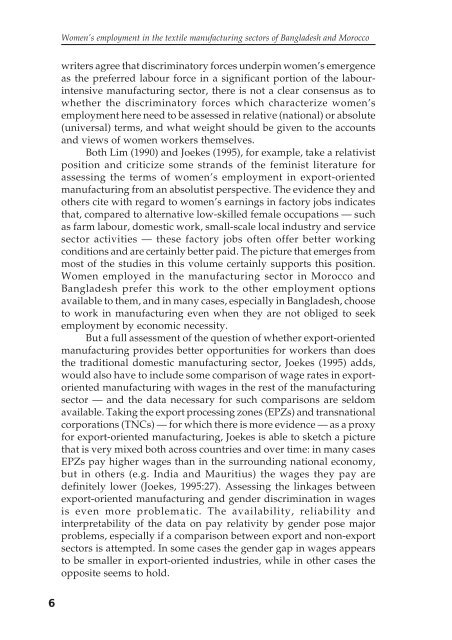Women's Employment - United Nations Research Institute for Social ...
Women's Employment - United Nations Research Institute for Social ...
Women's Employment - United Nations Research Institute for Social ...
You also want an ePaper? Increase the reach of your titles
YUMPU automatically turns print PDFs into web optimized ePapers that Google loves.
Women’s employment in the textile manufacturing sectors of Bangladesh and Morocco<br />
writers agree that discriminatory <strong>for</strong>ces underpin women’s emergence<br />
as the preferred labour <strong>for</strong>ce in a significant portion of the labourintensive<br />
manufacturing sector, there is not a clear consensus as to<br />
whether the discriminatory <strong>for</strong>ces which characterize women’s<br />
employment here need to be assessed in relative (national) or absolute<br />
(universal) terms, and what weight should be given to the accounts<br />
and views of women workers themselves.<br />
Both Lim (1990) and Joekes (1995), <strong>for</strong> example, take a relativist<br />
position and criticize some strands of the feminist literature <strong>for</strong><br />
assessing the terms of women’s employment in export-oriented<br />
manufacturing from an absolutist perspective. The evidence they and<br />
others cite with regard to women’s earnings in factory jobs indicates<br />
that, compared to alternative low-skilled female occupations — such<br />
as farm labour, domestic work, small-scale local industry and service<br />
sector activities — these factory jobs often offer better working<br />
conditions and are certainly better paid. The picture that emerges from<br />
most of the studies in this volume certainly supports this position.<br />
Women employed in the manufacturing sector in Morocco and<br />
Bangladesh prefer this work to the other employment options<br />
available to them, and in many cases, especially in Bangladesh, choose<br />
to work in manufacturing even when they are not obliged to seek<br />
employment by economic necessity.<br />
But a full assessment of the question of whether export-oriented<br />
manufacturing provides better opportunities <strong>for</strong> workers than does<br />
the traditional domestic manufacturing sector, Joekes (1995) adds,<br />
would also have to include some comparison of wage rates in exportoriented<br />
manufacturing with wages in the rest of the manufacturing<br />
sector — and the data necessary <strong>for</strong> such comparisons are seldom<br />
available. Taking the export processing zones (EPZs) and transnational<br />
corporations (TNCs) — <strong>for</strong> which there is more evidence — as a proxy<br />
<strong>for</strong> export-oriented manufacturing, Joekes is able to sketch a picture<br />
that is very mixed both across countries and over time: in many cases<br />
EPZs pay higher wages than in the surrounding national economy,<br />
but in others (e.g. India and Mauritius) the wages they pay are<br />
definitely lower (Joekes, 1995:27). Assessing the linkages between<br />
export-oriented manufacturing and gender discrimination in wages<br />
is even more problematic. The availability, reliability and<br />
interpretability of the data on pay relativity by gender pose major<br />
problems, especially if a comparison between export and non-export<br />
sectors is attempted. In some cases the gender gap in wages appears<br />
to be smaller in export-oriented industries, while in other cases the<br />
opposite seems to hold.<br />
6
















